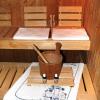CYBERMED LIFE - ORGANIC & NATURAL LIVING
CYBERMED LIFE - ORGANIC & NATURAL LIVING
 A sauna (/ˈsɔːnə/ or /ˈsaʊnə/; Finnish pronunciation: "sɑunɑ"), or sudatory, is a small room or building designed as a place to experience dry or wet heat sessions, or an establishment with one or more of these facilities. The steam and high heat make the bathers perspire. Infrared therapy is often referred to as a type of sauna, but according to the Finnish sauna organizations, infrared is not a sauna.
A sauna (/ˈsɔːnə/ or /ˈsaʊnə/; Finnish pronunciation: "sɑunɑ"), or sudatory, is a small room or building designed as a place to experience dry or wet heat sessions, or an establishment with one or more of these facilities. The steam and high heat make the bathers perspire. Infrared therapy is often referred to as a type of sauna, but according to the Finnish sauna organizations, infrared is not a sauna.
Sauna therapy is an important part of the healing process. It has been used for hundreds of years in many countries as a standard health practice. Studies document the effectiveness of sauna therapy for persons with hypertension, congestive heart failure, and for post-myocardial infarction care. Some individuals with chronic obstructive pulmonary disease (COPD), chronic fatigue, chronic pain, or addictions can benefit as well. Existing evidence supports the use of saunas as a component of detoxification protocols for environmentally-induced illness. Sauna therapy can also boost the immune system and be used for routine colds and autoimmune conditions.
Sauna therapy is considered safe with most persons the exceptions would include pregnant women and persons with existing cardiovascular disease. Saunas are considered to be safe when used correctly. Various protocols exist for sauna therapy but the main protocol is to alternate time in the sauna with cold shower rinse during a one- hour treatment session. Typically, a session is designed so a person spends 10 minutes in the hot sauna followed by 30 second cold shower rinse, this is repeated 5 times, until the one-hour session is over.
Sauna therapy is used for:
High blood pressure
Stress
Chronic fatigue
Viral infections
Bacterial infections
Fibromyalgia
Weight loss
Detoxification
Autoimmune disease
Cardiovascular conditions
Pulmonary conditions
Physiologic Effects of Sauna:
Increases peripheral circulation
Decreases circulation to muscles, kidney and viscera
Increases metabolic rate
Increases O2 consumption
Water loss with maximal cutaneous circulation
Increase of heart rate to 100-160 bpm
Toxins in subcutaneous fat pads release through skin.
Toxins are released from fat goes into circulation.